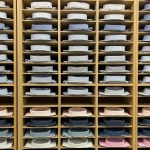
Whether you’re on a tight budget or you just want to be more organized, wardrobe basics make quality affordable and keep your closet streamlined. Here’s how to build a capsule wardrobe for the well-dressed man who enjoys simplicity.
What Is a Capsule Wardrobe for Men?
Building a capsule wardrobe is a practical and efficient approach to curating a versatile and cohesive collection of clothing. By carefully selecting a limited number of good-quality wardrobe basics that can be mixed and matched effortlessly, you’ll always have the right thing to wear.
Basics consist of trousers, suits, shirts, sweaters, jackets, and coats.
These should mostly be of solid, neutral, interchangeable colors. For shirts, you can use patterns and a more varied palette to ring the changes, but if you’re on a budget, it’s better to keep these neutral, too. Ties are a good way of adding color in a formal environment.
Another important feature of wardrobe basics is longevity. Buying fewer clothes allows for better quality and classic designs that won’t go out of style too quickly.
In other words, no more fast-fashion regrets.
But it doesn’t have to be minimalistic. You should have no more and no less than you feel you really need. Take me, for instance. I don’t like to wear the same dress shirt twice in a month; I therefore allow myself 20 of them. But they all coordinate with the rest of my wardrobe. It’s more about streamlining and functionality than going without.
Functionality refers to clothes that support your lifestyle.
To demonstrate this, I’ll use my wardrobe as an example later in this post.
But first, let’s take a look at four fundamental factors to consider before building your capsule wardrobe: color, texture, cut, and accessories.
The Right Colors for Your Wardrobe Basics
It’s important to know which colors flatter you and how to combine them.
For this, a basic understanding of color theory is useful.
The Color Wheel
The color wheel is a visual tool that aids in creating on-point color schemes when mixing and matching. Take a look at the diagram below and the hexagon and two triangles at its center.
Primary colors are red, yellow, and blue. Mixtures of these are secondary colors: orange, purple, and green. Tertiary colors are primary and secondary colors mixed in equal parts, for example chartreuse, amber, and vermillion. A primary color and its opposite secondary color, like blue and orange, are complementary; when paired, they form a striking contrast.
Your eye should tell you if a color scheme is right or wrong, but contemplating how colors interact and relate to one another may inspire new ideas when coordinating items, especially ties with dress shirts.

Warm and Cool Colors
Cool colors range from green to magenta and appear on the lower half of the color wheel. Warm colors are found on the upper half.
Neutral tones are those that do not appear on the wheel, like brown, black, white, beige, taupe, and gray. Their undertone determines their temperature and the colors with which they are best matched. Warm gray, for example, has a yellow undertone, while cool gray has a blue undertone. Warm brown has more red than cool brown, which is also less saturated.
You could coordinate a light blue shirt with either cool gray or cool brown trousers. But the same blue would also match warm gray, providing a subtle contrast.
Which Colors Suit You?
To tell which colors flatter you, stand before a mirror in a fluorescent-lit room wearing a pure white shirt. Holding a white towel or sheet to your neck would also do the trick.
If your face appears sallow, yellowish, olive, or golden, you need warm colors. If it’s rosy or pink, you need cool colors.
Or look at the veins of your inner wrists. If they’re blue or purple, you’re a cool type. Green indicates a warm type. People with a mix of both are neutral; as such, they’re able to wear most colors.
When building your capsule wardrobe, concentrate only on colors that suit you.
Texture
Pay as much attention to texture as you do to color.
Contrast rough or heavy fabrics with smooth textures to set off their structure.
For example, a chunky knit sweater would harmonize well with a waxed or leather jacket but not with tweed.
Cut
Cut is important because it determines how well a garment “hangs” and how comfortable you feel wearing it. Comfort ensures free, natural movement. Armholes that bind, for example, will make you appear stiff and undermine poise.
If you own a piece of clothing that you like too much to throw away, but it doesn’t quite look or feel right, take it to a tailor who may be able to alter it.
Accessories
Women use accessories to keep their wardrobe basics interesting, colorful, and up-to-date. With the exception of ties, men rely more on shirts for this—I certainly do. Accessorizing is nevertheless important.
Belts, suspenders (braces), ties, tie clips, cufflinks, watches, and shoes can make a huge difference to your overall appearance. But depending on taste and lifestyle, we may implement these in different ways.
This is how I wear accessories:
- To keep things simple, I generally use only black belts of medium width that I can wear with jeans or cloth trousers. Your belt should match your shoes.
- Suspenders are an interesting alternative that I’m still experimenting with.
- I have one pair of cufflinks for formal occasions like weddings. They’re also appropriate for black-tie events and some business settings.
- I get by easily on two pairs of black shoes—Hushpuppies that I wear all the time, and dress shoes for formal occasions. Due to comfort issues, I dislike new footwear.
- Watches are my only jewelry: a robust Festina for home and a vintage Omega when I go out.
- Although I possess only two tie clips, I have more ties than I have shirts, all fashionably shaped and as subdued in color as the rest of my wardrobe.
Accessories can also work as statement pieces. Patent leather shoes and striking belt buckles are good examples. A capsule wardrobe does not have to be low-key.
How to Shop for Wardrobe Basics
Don’t build your capsule wardrobe in one go. Shop according to season.
Lighter spring and summer clothes tend to be less expensive than heavier winter garments, so this is the best time to start if you’re on a budget. You should then have most of what you need before summer is over, which means you’ll be able to start saving for your winter clothes.
Formal
The following wardrobe suggestion is based on my own and works well for an office or corporate environment. These are also the clothes I wear for worship. You’re probably not as staid as me, so substitute my choices for items that better accommodate your lifestyle, taste, and age. Depending on your coloring and the rest of your wardrobe, you may also wish to swap gray for beige and taupe.
- Two suits in black and gray. This allows for good mixing and matching. The black jacket doubles up as a blazer, and the gray one as a sports jacket, which I sometimes wear with jeans in my spare time.
- Two pairs of cloth trousers in black and/or navy. These I team with a shirt and cardigan sweater when I don’t want to wear a suit.
- At least five dress shirts. Mine are mostly striped and in various colors of the cool category. I sometimes wear them casually, but mostly match them with a striped or motif tie.
- Two or three fine-knit cardigan sweaters. Mine are in navy, gray, and burgundy. I also wear them casually.
- A heavy black or gray overcoat. This can be worn with all garments, casual and formal.
- A lighter spring/fall coat in black or gray to wear over suits.
By the way, medium-weight suits can be worn throughout the year in a northwestern European climate. Choose 10 or 12 oz. for wool suits.
Casual
I don’t have a separate casual wardrobe—just a few additions. The following is based on this.
- Two pairs of dark blue jeans and two pairs of chinos in gray and navy. The latter are also suitable for the office in warmer weather.
- At least five polo shirts. Mine are all in white. I usually wear them beneath a cardigan sweater unless the weather is very warm.
- A black or gray down jacket for winter.
- A navy or gray windbreaker for spring and fall.
As you can see, many of my clothes can be worn both casually and formally. And all colors coordinate. Every item in my closet must earn its place. Bear this in mind when building your capsule wardrobe.
Edit and Update Your Wardrobe Regularly
Periodically review your clothes and remove anything that no longer fits, is worn out, or has lost its appeal.
By being vigilant and keeping your wardrobe updated, you’ll ensure that it’s always appropriate to your lifestyle and needs.
Organizing and Maintaining Your Capsule Wardrobe
I’ve dedicated an entire post to decluttering and maintaining a men’s closet, but keeping your capsule wardrobe organized is key to maximizing its efficiency.
Whether you use closet organizers, space-saving hangers, or storage bins, arrange your clothing by color and category (formal, casual, sport, etc.). This will enable you to find matching items more easily when assembling an outfit.
A neat and tidy closet not only looks good but also helps streamline your daily dressing routine.
© 2025 J. Richardson
Related Posts
Disclaimer
The information provided by The Neat and Tidy Man (“we,” “us,” or “our”) on theneatandtidyman.com (the “site”) is for general informational purposes only. While we endeavor to keep the information up to date and correct, we make no representation or warranty of any kind, express or implied, regarding the completeness, accuracy, reliability, suitability, adequacy, validity, or availability of any information on the site. Under no circumstance shall we have any liability to you for any loss or damage of any kind incurred as a result of the use of the site or reliance on any information provided on the site. Your use of the site and your reliance on any information on the site is solely at your own risk.

